Looking for How to Make Your Own Home Canned Sweet Potatoes (complete directions with photos) in 2025? Scroll down this page and follow the links. And if you bring home some fruit or vegetables and want to can, freeze, make jam, salsa or pickles, see this page for simple, reliable, illustrated canning, freezing or preserving directions. There are plenty of other related resources, click on the resources dropdown above. If you are having a hard time finding canning lids, I've used these, and they're a great price & ship in 2 days.
If you have questions or feedback, please let me know! There are affiliate links on this page. Read our disclosure policy to learn more.
How to Make Your Own Home Canned Sweet Potatoes (complete directions with photos)
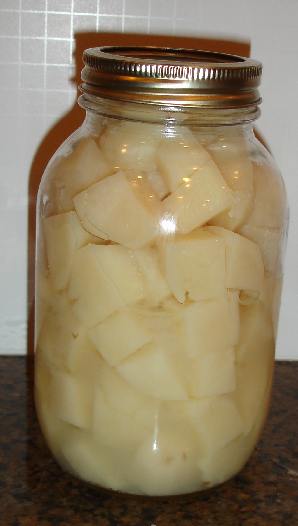 How to Make Homemade Canned Sweet Potatoes
How to Make Homemade Canned Sweet Potatoes
Canning your own Sweet Potatoes is easy to do at home! The only trick is, you
really do need a Pressure Canner. You might ask why can them, since sweet potatoes are readily available year round, but if you grow your own organic sweet potatoes, don't have a cold cellar to store them, or simply want sweet potatoes that are ready to use in cooking (like mash sweet potatoes, scalloped sweet potatoes, etc.) then this is the way to go. So, here's how to can sweet potatoes! The directions are complete with instructions in easy steps and completely illustrated. In the winter when you open a jar, the sweet potatoes will taste MUCH better than any store-bought canned sweet potatoes.You DO need a Pressure Canner! Every university food science department and the government will tell you that it just is not safe to use the water bath bath method; it takes the higher temperatures of the pressure canner to kill the botulism bacteria. BUT, with a pressure canner it's easy. And although a Pressure Canner costs $100 to $200 (see this page for pressure canners models, makes and prices), they last a lifetime, and your children and grandchildren may be using it. You can also find free information from the USDA in this PDF file (it will take a while to load!) about selecting and using canners here!
Prepared this way, the jars have a shelf life of about 12 months, and aside from storing in a cool, dark place, require no special attention.
Directions for Making Canned Sweet Potatoes
Ingredients

- Sweet Potatoes (see step 1) Any color or variety (they do come in yellow, orange, white, even blue and purple.)
- Lemon juice or Fruit Fresh
Equipment
- Jar grabber (to pick up the hot jars)
- Jar funnel ($4 at mall kitchen stores and local "big box" stores, but it's usually cheaper online from our affiliates)
- At least 1 large pot
- Large spoons and ladles,
- Canning jars (often called Ball jars, Mason jars or Kerr jars) (Publix, Kroger, other grocery stores and some "big box" stores carry them - now about $12 per dozen quart jars (up 50% in 2 years!) including the lids and rings)
- Salt (optional - I don't use any)
- One 6 - 8 quart pot or saucepan
- 1 Pressure Canner (a large pressure pot with a lifting rack to sanitize the jars after filling (about $75 to $200 at mall kitchen stores and "big box" stores, but it is cheaper online; see this page for more information). For low acid foods (most vegetables, you can't use an open water bath canner, it has to be a pressure canner to get the high temperatures to kill the bacteria. If you plan on canning every year, they're worth the investment.
Recipe and Directions
Step 1 - Selecting the sweet potatoes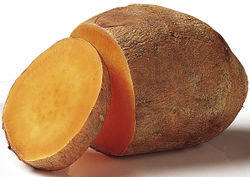
The most important step! Look for firm, well-shaped sweet potatoes with clean, smooth skins. Avoid any with soft spots or bruises. Do not refrigerate, because cold temperatures are harmful to sweet potatoes. They should have been cured (gently left to air dry) for at least one week, after they have been dug and before you may can them.
How many sweet potatoes and where to get them
You can grow your own, pick your own, or buy them at the grocery store. It takes about an average of 13 pounds to make one full canner load of 9 pints. This works out to an average of 11/2 pounds per quart.
Step 2 - Prepare the jars and pressure canner
Wash the jars and lids
This is a good time to get the jars ready! The dishwasher is fine for the jars; especially if it has a "sanitize" cycle. Otherwise put the jars in boiling water for 10 minutes. I just put the lids in a small pot of almost boiling water for 5 minutes, and use the magnetic "lid lifter wand" (available from target, other big box stores, and often grocery stores; and available online - see this page) to pull them out.
Get a large pot of water boiling over low heat
We will use this water to pour over the sweet potatoes and fill each jar with liquid, after we've packed them full of sweet potatoes. I use the large sauce pan or 10 qt pot, so that there is plenty of clean, boiling water ready when I need it.
Get the pressure canner heating up
Rinse out your pressure canner (at right in the picture), put the
rack plate in the bottom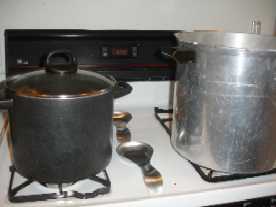 ,
and fill it to a depth of 4 inches with hot tap water. (of course,
follow the instruction that came with the canner, if they are
different). Put it on the stove over low heat, with the lid OFF of it,
just to get it heating up for use later on.
,
and fill it to a depth of 4 inches with hot tap water. (of course,
follow the instruction that came with the canner, if they are
different). Put it on the stove over low heat, with the lid OFF of it,
just to get it heating up for use later on.
Get 1 more pot going on the stove over high heat
You will need one large pot (12 quarts or larger, at left in the photo above) 3/4 filled with water, in which you will blanch the sweet potatoes.Step 3 -Wash the sweet potatoes!
I'm sure you can figure out how to rinse the sweet potatoes in plain cold or lukewarm water and a vegetable scrubber. Cut out any bruised and soft spots. Don't worry about surface discoloration.
Step 4 - Partially cook the sweet potatoes
Boil the sweet potatoes until they are partially soft (about 15 to 20 minutes, longer if they are very big).
Step 5 - Drain the sweet potatoes, and peel them
Cool only enough to be able to handle them. The skins should slide off; just use a knife to cut both ends off to be able to get hold of the skin and pull it off.
Step 6 - Cut the potatoes to fit the jars
Cut potatoes, if needed, so pieces are uniform in size and will pack better.. CAUTION: Do not mash or puree pieces. I usually cube them. Fill hot jars, leaving 1-inch headspace. Add 1 teaspoon salt per quart jar, if desired.
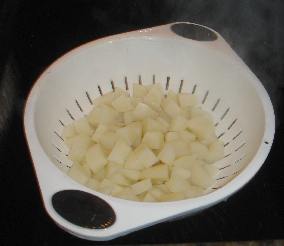 Fill
jars, leaving a full 1-inch of headspace. You may add 1 teaspoon of salt
to each quart jar, if desired, for taste (it is not a preservative - it
is only for taste. I omit it).
Fill
jars, leaving a full 1-inch of headspace. You may add 1 teaspoon of salt
to each quart jar, if desired, for taste (it is not a preservative - it
is only for taste. I omit it).
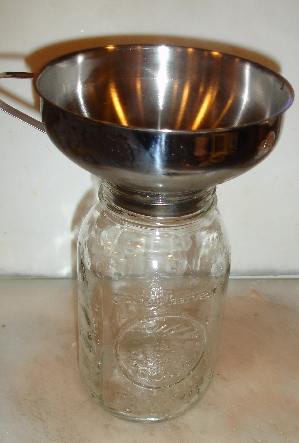
Fill jars loosely with sweet potatoes. Be sure to leave 1 inch of space at the TOP of the jar. That is called "headspace" and is needed for expansion during heating.
Step 7 - Fill the jars with boiling water
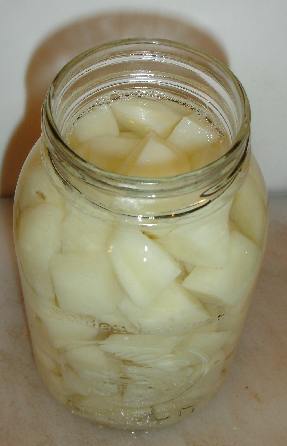 Fill
the jars up to 1 inch from the top with
your choice of fresh boiling water or syrup (use 1 cup sugar per quart
of water for a light syrup).
Fill
the jars up to 1 inch from the top with
your choice of fresh boiling water or syrup (use 1 cup sugar per quart
of water for a light syrup).
Use a ladle or pyrex measuring cup to carefully fill each packed jar with water from pot of boiling water. The sweet potatoes should be covered and there should still be 1 inch of airspace left in the top of each jar. Be careful not to burn yourself, (or anyone else - children should be kept back during this step!)
Step 8 - Put the lids and rings on
Put the lids on each jar and seal them by putting a ring on and screwing it down snugly (but not with all your might, just "snug").
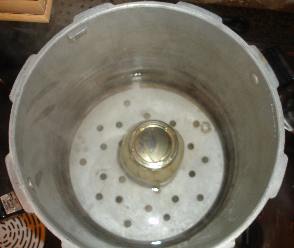 Step
9 - Put the jars in the pressure canner and the lid on the canner (but still
vented)
Step
9 - Put the jars in the pressure canner and the lid on the canner (but still
vented)
Using the jar tongs, put the jars on the rack in the canner. By now the water level has probably boiled down to 3 inches. If it is lower than that, add more hot tap water to the canner. When all the jars that the canner will hold are in, out on the lid and twist it into place, but leave the weight off (or valve open, if you have that type of pressure canner).
Step 10 - Let the canner vent steam for 10 minutes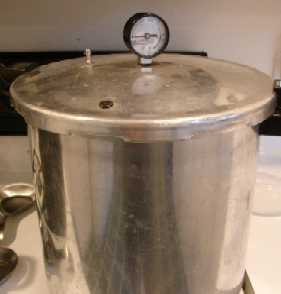
Put the heat on high and let the steam escape through the vent for 10 minutes to purge the airspace inside the canner.
Step 11 - Put the weight on and let the pressure build
After 10 minutes of venting, put the weight on and close any openings to allow the pressure to build to 11 pounds.
Step 12 - Process in the Pressure Canner
If you have a dial-type pressure canner like I do, once the gauge hits 11 pounds, start your timer going - for 35 minutes. Adjust the heat, as needed, to maintain 11 pounds of pressure.
Note: the charts below will help you determine the right processing time and pressure, if you have a different type of canner, or are above sea level.
|
Recommended process time for Sweet Potatoes in a dial-gauge pressure canner. |
|||||
| Canner Pressure (PSI) at Altitudes of | |||||
| Jar Size | Process Time | 0 - 2,000 ft | 2,001 - 4,000 ft | 4,001 - 6,000 ft | 6,001 - 8,000 ft |
| Pints | 65 min | 11 lb | 12 lb | 13 lb | 14 lb |
| Quarts | 90 | 11 | 12 | 13 | 14 |
|
Recommended process time for Sweet Potatoes in a weighted-gauge pressure canner. |
|||
| Canner Pressure (PSI) at Altitudes of | |||
| Jar Size | Process Time | 0 - 1,000 ft | Above 1,000 ft |
| Pints | 65 min | 10 lb | 15 lb |
| Quarts | 90 | 10 | 15 |
It is important to learn how to operate your pressure canner by reading the owner's manual that came with your particular canner. If you cannot find your owner's manual, you can obtain find one online: Here is where to find some common manufacturer's manuals:
or by contacting the company that made your canner. Give the model number to the manufacturer, and they will send you the right manual. Click here for more information about pressure canners and a variety of models you can order.
Step 13 - Turn off the heat and let it cool down
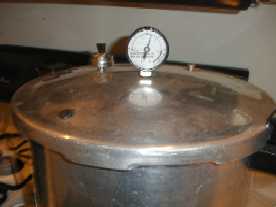 When
the processing time from the chart above is up, turn off the heat, and
allow the pressure canner to cool and the pressure to drop to zero
before opening the canner. Let the jars cool without being
jostled. After the pressure drops to zero (usually, you can tell but the
"click" sound of the safety release vents opening, as well as but the
gauge. Let the pressure in the canner drop to zero by itself. This
may take 45 minutes in a 16-quart canner filled with jars and almost an
hour in a 22-quart canner. If the vent is opened before the pressure
drops to zero OR if the cooling is rushed by running cold water over the
canner, liquid will be lost from the jars. Too rapid cooling causes loss
of liquid in the jars!
When
the processing time from the chart above is up, turn off the heat, and
allow the pressure canner to cool and the pressure to drop to zero
before opening the canner. Let the jars cool without being
jostled. After the pressure drops to zero (usually, you can tell but the
"click" sound of the safety release vents opening, as well as but the
gauge. Let the pressure in the canner drop to zero by itself. This
may take 45 minutes in a 16-quart canner filled with jars and almost an
hour in a 22-quart canner. If the vent is opened before the pressure
drops to zero OR if the cooling is rushed by running cold water over the
canner, liquid will be lost from the jars. Too rapid cooling causes loss
of liquid in the jars!
Step 14 - Remove the jars
 Lift
the jars out of the water and let them cool on a wooden cutting board or a
towel, without touching or bumping them in a draft-free place
(usually takes overnight), here they won't be bumped. You can then remove
the rings if you like, but if you leave them on, at least loosen them
quite a bit, so they don't rust in place due to trapped moisture. Once the
jars are cool, you can check that they are sealed verifying that the lid
has been sucked down. Just press in the center, gently, with your finger.
If it pops up and down (often making a popping sound), it is not sealed.
If you put the jar in the refrigerator right away, you can still use it.
Some people replace the lid and reprocess the jar, then that's a bit iffy.
If you heat the contents back up, re-jar them (with a new lid) and the
full time in the canner, it's usually ok. You're done!
Lift
the jars out of the water and let them cool on a wooden cutting board or a
towel, without touching or bumping them in a draft-free place
(usually takes overnight), here they won't be bumped. You can then remove
the rings if you like, but if you leave them on, at least loosen them
quite a bit, so they don't rust in place due to trapped moisture. Once the
jars are cool, you can check that they are sealed verifying that the lid
has been sucked down. Just press in the center, gently, with your finger.
If it pops up and down (often making a popping sound), it is not sealed.
If you put the jar in the refrigerator right away, you can still use it.
Some people replace the lid and reprocess the jar, then that's a bit iffy.
If you heat the contents back up, re-jar them (with a new lid) and the
full time in the canner, it's usually ok. You're done!
Sweet Potato Basics
Storing Sweet Potatoes
Cooking Sweet Potatoes
Freezing Sweet Potatoes
Yes, you can also freeze sweet potatoes. Wash sweet potatoes that have been cured for at least one week. Cook until almost tender in water, steam, a pressure cooker or the oven. Let stand at room temperature until cool. Peel sweet potatoes; cut in halves; slice or mash.
To prevent darkening, dip whole sweet potatoes or slices for 5 seconds in a solution of 1/2 cup lemon juice to 1 quart water. To keep mashed sweet potatoes from darkening, mix 2 tablespoons orange or lemon juice with each quart of mashed sweet potatoes. Pack into containers, leaving 1/2 headspace. Seal and freeze.
Sweet potato recipes
SWEET POTATO PIE
Makes one 9-inch pie
Cook 2 pounds of fresh sweet potatoes (about 3 or 4 medium) by baking or
boiling. When cool enough to handle, peel the sweet potatoes, or scoop out the
flesh, and puree in a food processor with 2 tablespoons melted butter or
margarine.
In a mixing bowl, combine 3/4 cup sugar, 1/4 teaspoon salt, 1 teaspoon ground cinnamon, 3/4 teaspoon ground ginger, 1/4 teaspoon ground cloves and 1/2 teaspoon grated lemon peel. Add the sweet potato mixture and mix well. Beat in 3 eggs. Stir in 12 ounces skimmed, evaporated milk and mix until well-blended. Pour the mixture into a 9-inch pastry shell. Bake in a preheated 400 °F. oven 40 to 50 minutes or until knife inserted in the center comes out clean.
Other Equipment:
See the canning supplies page if you need any of these.
From left to right:
- Jar lifting tongs
helpful to pick up hot jars - Lid lifter
- to remove lids from the pot
of hot water - Lids
- disposable - you may only
use them once - Ring
- holds the lids on the jar until after
the jars cool - then you remove them, save them and reuse them - Canning Jar funnel
- to fill the jars
Pressure canners!If you want to can low-acid foods such as red meats, sea food, poultry, milk, and all fresh vegetables with the exception of most tomatoes, you will need a Pressure Canner. These foods fit into the low acid group since they have an acidity, or pH level, of 4.6 or greater. The temperature which must be reached and maintained (for a specified amount of time) to kill the bacteria is 240 F. Pressure canning is the only canning method recommended safe by the U.S.D.A. for low-acid foods such as vegetables, meats, and fish. Ordinary water bath canners can only reach 212 F and cannot to kill the types of bacteria that will grow in low acid foods. This temperature can be reached only by creating steam under pressure as achieved in quality pressure canners. There are several manufacturers of pressure canners. The two leading ones are Presto and All American (Wisconsin Aluminum). They are more expensive than water bath canners, but extremely well built - I bought mine in 1988 and it still looks and works like new! Click here for my page about pressure canners, models and prices.
|
|||

|
Presto 01781 23-Quart Pressure Cooker/CannerThis is usually one of the best-priced pressure canners. They are reliable and inexpensive. I've had mine for 40 years. There is also a 16 quart version for even less. Click on the links at left or above for more info and current pricing. |
||
|
|
Shown at left is the Presto 23 quart pressure canner. Features below and
click here for more information or to purchase from Target.
See the seller's website for features, pricing and user reviews! |
||
|
All-American 915 pressure canner
Pressure canner: All American 921, 21.5qt Pressure Cooker/Canner, never needs gaskets, Great for Gas, Electric or Flat Top Stoves - Made in the USA All-American 930 Pressure Canner |
All American Pressure Canner and Cookers - In 3 sizesSee the seller's website for features, pricing and user reviews! |
||